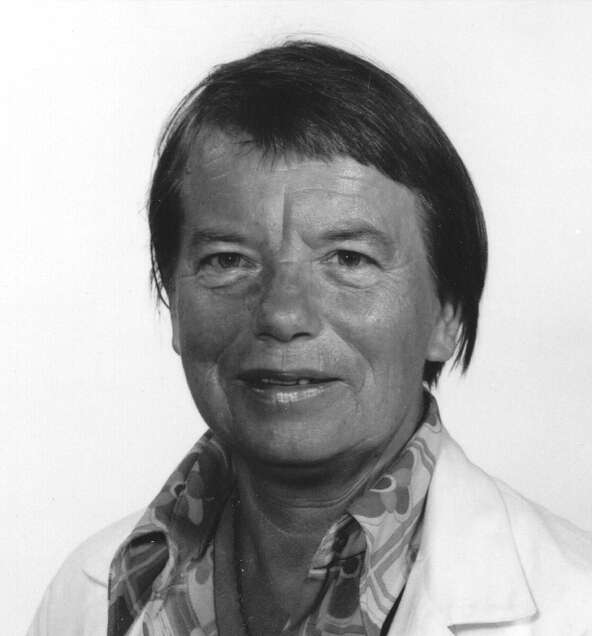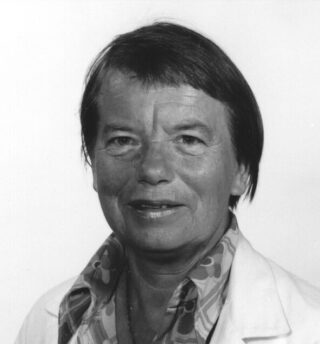- Entry type: Person
- Entry ID: AWE4910
Liepa, Zenta
- Liepa-Liepins, Zenta Rosalia

- Born 22 January 1927, Riga, , Latvia
- Died 25 October 1987, Canberra, Australian Capital Territory, Australia
- Occupation Refugee, Research assistant
Summary
A former World War II refugee from Latvia, Zenta was asked to work at the CSIRO to assist communication between a Ukrainian refugee entomologist and his work colleagues. Working in CSIRO Entomology, specialising in assisting those working with Diptera (flies), became the rest of her life’s work. Her assistance was so valued that there are now at least two genera and 19 species named in her honour.
Details
Zenta’s mother died at her birth so she was brought up by a grandmother and an aunt. The aunt worked for the government-run telephone company while her father, from a farming family, had become a shopkeeper in Riga. When Zenta was aged 13, her life was interrupted by war: Soviet troops entered her homeland on 17 June 1940. In June 1941 at least 15,000 Latvians, identified as ‘anti-Soviet elements’ were deported to Siberia, and shortly afterwards, the Germans drove out the Soviet forces. Zenta’s older brother was conscripted into the Latvian Legion, part of the Waffen SS, the armed wing of the Nazi Party, and was killed by the Soviets outside Riga in 1944.
In October 1944, an opportunity arose for Zenta to leave Riga when two German soldiers entered her father’s shop for cigarettes and, seeing her in tears, advised her to be at their ship next morning, as it would be the last to leave Riga. Before dawn she walked with her aunt across Riga to the Daugava River bridge where the ship was preparing to cast off. Zenta departed Latvia on 4 October 1944 through the Soviet shelling of the city and its harbour, through the minefields of the Baltic, to the north German coast, as a deck passenger. She found her way to southern Germany and a transit camp in Dachau, near Munich, then further west to a munitions factory in the village of Leibi, near Ulm, until the end of the war. In 1945, she was sent further west again to a camp for displaced people in the town of Schwabische Gemund. From there she was able to continue her education at the nearby Göppingen Latvian High School.
In 1946, she moved further west again, to the Esslingen displaced persons’ camp where she finished high school and completed the qualification course for Swedish massage. She did not practise massage, working instead in the American Army Special Service Club in Esslingen as an assistant librarian. There she heard that the Australian Government wanted to resettle a group of the displaced persons. She saw it as a challenge to go to the other side of the world, as fulfillment of her aspiration to be an archaeologist, in which she had always expected a professional career of world-wide travelling.
Within two weeks, Zenta was on the ship to Australia. In this short period of time, she had travelled from the Esslingen camp to the Butzbach camp where a three-man Australian team was interviewing. Having been accepted and having passed her medical and security checks, she returned to Esslingen to pack her few belongings and from Butzbach was then sent north to a former Luftwaffe base near Bremerhaven.
The shipload of refugees assembled there was the first group of migrants of non-British origin ever to be selected by the Australian government. Their ship was the USAT General Stuart Heintzelman. It had been built as a troop transport for the US Army, so it was operated by the Army while crewed by the US Navy. Even though the four-week voyage was more like a holiday after seven years of war, there was military discipline on board. All of the passengers were expected to undertake some work such as translating the daily newsletter into their mother tongues and staffing the ship’s library. In addition to reading, recreation focussed on music making, chess and nightly films and dances.
The voyage ended with the disembarkation of the Heintzelman’s passengers at Fremantle on 28 November 1947. After four nights in Army camps in Perth, they boarded the Kanimbla, a former coastal steamer still under the control of the Australian Navy. They arrived at Port Melbourne on 7 December 1947 and disembarked the next day. By 9 December they were settling into another camp routine, this time at the Bonegilla Migrant Reception and Training Centre, near Wodonga on the Murray River. Zenta’s Bonegilla record card shows that she was sent to Canberra to work as a waitress at Acton Guest House only nine days later. She spent the rest of her life in Canberra.
After the Acton Guest House, Zenta moved her workplace to Lawley House. It was there that she got talking with one of the residents, Dr Sergey Jacques Paramonov, who had worked in the Zoological Institute of the Ukrainian Academy of Science. During the war, he was deported to Germany together with other staff of the Academy, and after the war, found himself in Paris. Through a contact in the British Museum, he was offered a taxonomic position in the CSIRO’s Entomology division and had arrived in Canberra in March 1947, some months before Zenta. Paramonov had sufficient English to read the scientific literature but not much practice in spoken English. Later, Zenta’s boss wrote that Paramonov ‘was a highly cultured man, fluent not only in his native Russian but also in his mother’s French and the German of his science: but his English was awful! No doubt Zenta’s general education played a part: but it seems very likely that her fluent German greatly influenced her next step, to a post as Paramonov’s assistant in the Division of Entomology.’
Zenta commenced work with CSIRO as a temporary Laboratory Assistant in the Museum Section on 6 February 1950. Her position was made permanent after she obtained Australian citizenship on 11 June 1953. She used the application for citizenship to change her surname from Liepa-Liepins to Liepa.
Don Colless, her supervisor, described her working life thus: ‘During the next 10 years Paramonov passed on to Zenta his great skill and meticulous standards in the collection and preparation of specimens, as well as a wide acquaintance with the taxonomy and biology of the Diptera. In lab and field she served him faithfully while together they built up a magnificent collection of Australian Diptera. And from May 1960, she found herself attempting to pass on her acquired skills to Paramonov’s successor (Colless) who arrived with a specialised knowledge of mosquitoes and little else! Nor did her service to Paramonov end there; for another 7 years she acted as his part-time assistant and especially during his last long illness, his factotum and loyal friend.
‘Apart from these technical services, Zenta established two important projects: a card catalogue of Australian Diptera and (on her own initiative) a gazetteer of Australian place names … Talents of this kind enabled her also to publish a valuable bibliography of Paramonov’s voluminous taxonomic output (1969), and later to do most of the hard work in our co-authored catalogue of Oriental Mycetophilidae (1973). Eventually she became largely responsible for searching the current literature for taxonomically important papers and dealing with a wide variety of requests for material or information. For these services regular promotions brought her in 1982 to Senior Technical Officer Grade 2, the effective ceiling for her post.’
In 1962 Zenta took up part-time studies at the Australian National University, majoring in History and Political Science and graduating with a Bachelor of Arts degree in 1967. She enrolled in a Master’s degree course in 1968 but did not finish it. She became involved in Liberal Party politics both on and off campus. Don Colless said that her studies and political activities did not bring ‘any reduction in the enthusiasm she brought to her work. She had, in fact, an enormous capacity for work that interested her. Perhaps her case might warn us, against too rigidly favouring the scientifically trained as assistants to taxonomists.’
Her particular skill as an assistant was in sharing specimens of Diptera with her supervisors’ colleagues. The upshot of this collaboration is that Zenta Liepa has had at least two genera (Lieparella and Zentula) and 19 species of flies named after her. In the case of Lieparella zentae, both the generic and specific names honour her. The list includes: Anabarhynchus liepae, Anagonia zentae, Aphyssura zentae, Aphyssura liepae, Austrothaumalea zentae, Axinia zentae, Diplotoxa liepae, Lieparella zentae, Dolichopeza zenta, Drosophila zentae, Exeretonevra zentae, Helina liepae, Merochlorops liepae, Molophilus zenta, Orthogonis zentae, Paramonova zentae, Phytobia liepae, Stylogaster liepae, Tanytarsus liepae, and Zentula vittata.
In addition to her political interests, Zenta was also an officer-bearer of the Institute of International Affairs. Her spare-time interests included volleyball, hockey (playing for Canberra), horse riding, lawn bowls, cricket, amateur theatre, stamp collecting, knitting, crochet, tapestry and weaving. She also wrote poetry, but should not be confused with another Latvian poet of the same name, born 11 years earlier in 1916, who continued to reside in Latvia.
Having been introduced to smoking by the freely available cigarettes in the American Zone of postwar Germany, Zenta developed lung cancer. She retired from the CSIRO on the grounds of ill health on 6 August 1986 and died fourteen months later, on 25 October 1987. In her will she left $68,680 to the Canberra Branch of the Latvian Relief Society Daugavas Vanagi.
Archival resources
Digital resources
Published resources
- Journal Article
- Newspaper Article
- Book
- Edited Book
-
Site Exhibition
- From Lady Denman to Katy Gallagher: A Century of Women's Contributions to Canberra, Australian Women's Archives Project, 2013, http://www.womenaustralia.info/exhib/ldkg
-
Resource
- Trove: Liepa, Zenta (19270122-19871025), http://nla.gov.au/nla.party-1665912
